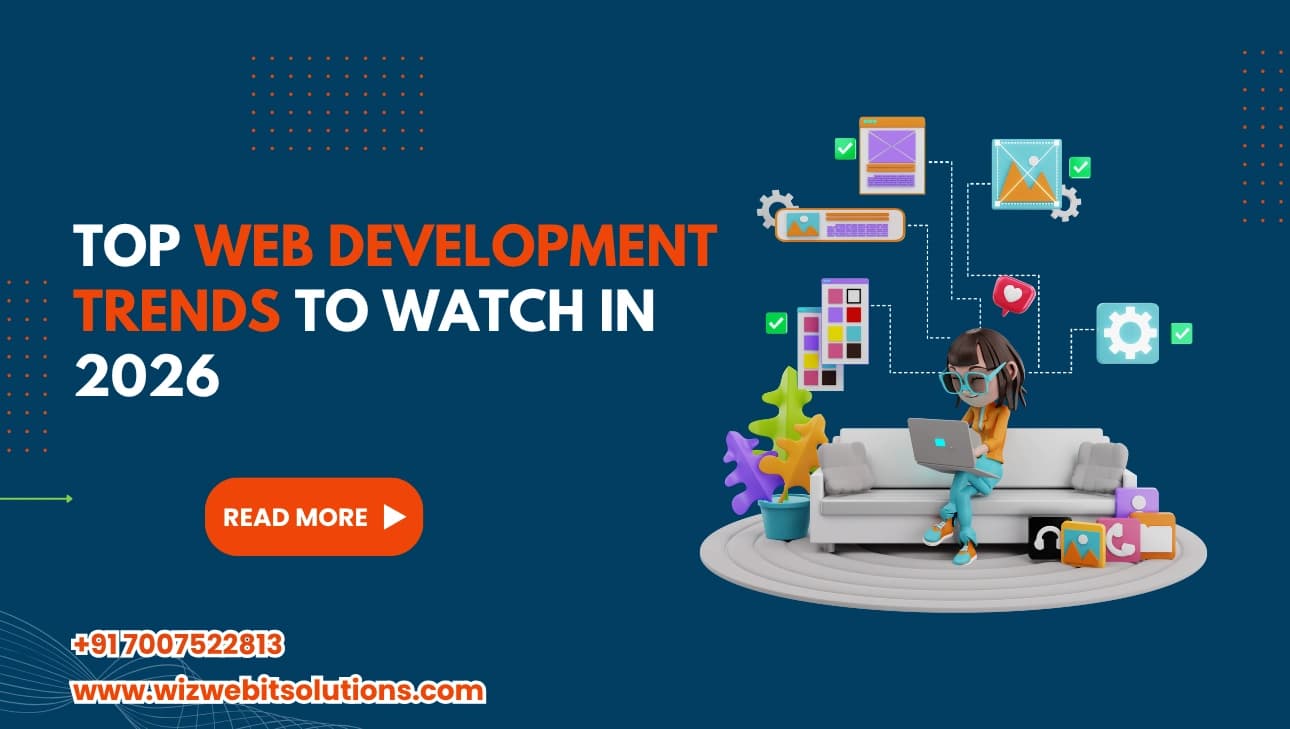Get in Touch
- Phone
+91 700 752 2813
- Email Now
hello@wizweb.in
Office No - 204 A-140, Sector 63 Road Noida, Uttar Pradesh 201301

The web keeps changing fast. If you build websites, run a small business, or hire Web Development Services, it helps to know what’s coming next. This article explains the Web Development Trends to watch in 2026 in simple English. I will explain what each trend means, why it matters, and how you or your team or your Web Development Services partner can use it. Read all the way through and you should feel confident about next steps.
AI tools that help write and review code are now real helpers. Tools like GitHub Copilot can suggest whole functions, find simple bugs, and save time. AI speeds up boring work so developers can focus on design and logic. These changes are one of the main Web Development Trends that will shape 2026. Use AI to prototype fast, but always check the output for security and correctness. If you work with Web Development Services, ask how they use AI to speed up delivery without losing quality.
WebAssembly lets developers run heavy code inside the browser at near-native speed. Instead of moving all heavy work to servers, Wasm runs CPU-heavy tasks on the user’s device. This leads to richer apps with faster responses and lower server costs for some tasks. Wasm is one of the important Web Development Trends that helps make web apps feel like desktop apps. Talk to your Web Development Services partner if your app does video, image work, or on-device machine learning.
Edge functions like Cloudflare Workers or Vercel Edge run code close to users. This reduces delay and makes sites feel faster. Serverless makes it cheap and easy to deploy small functions. The combination of edge and serverless is a strong Web Development Trends choice for making global sites feel fast. If your business needs speed around the world, your Web Development Services team can move some logic to the edge.
PWAs make websites behave like mobile apps: installable, offline-ready, and fast. PWAs help users who do not want to download an app but want a smooth experience. PWAs are part of modern Web Development Trends because they give a good user experience with low extra work. A Web Development Services provider can add a manifest and a service worker to turn a site into a PWA. That small work often brings a big improvement for users.
Headless CMS systems separate content from the front end. This lets the same content reach websites, apps, or kiosks through APIs. Jamstack builds pre-rendered pages and serves them via a CDN. This setup is a popular set of Web Development Trends because it makes pages fast, secure, and easier to scale. Talk to your Web Development Services team if you want faster loads and simpler publishing across channels.
New web transport tech like HTTP/3 helps pages load faster. Careful image loading and good Core Web Vitals scores remain vital for good user experience and SEO. Performance is among the top Web Development Trends because slow pages lose users. Ask your Web Development Services partner to run regular performance checks and fix large images and slow scripts. Small changes here can raise conversions and cut bounce rates.
Large teams break sites into small, independent parts called micro-frontends. Component libraries like React or Svelte make UIs consistent. This architecture is a practical Web Development Trends direction for big projects because it helps teams ship features faster and reduce merge conflicts. Your Web Development Services partner can set up a design system and component library for smoother updates and faster development.
Accessible sites reach more people and reduce legal risk. Sustainable hosting and well-optimized pages reduce cost and help the planet. Accessibility and sustainability are long-term Web Development Trends that show respect for users and good business sense. When hiring Web Development Services, make sure accessibility checks and sustainability practices are part of every project.
Low-code tools let non-developers build internal tools or simple customer flows fast. They match several Web Development Trends that focus on speed and simplicity. For complex, customer-facing products, expert Web Development Services still matter, but low-code can handle many internal tasks quickly and cheaply.
Security must be part of every project from day one. Use good authentication, secure session handling, automated scans, and data minimization. Privacy-first defaults build user trust. Security and privacy are core Web Development Trends because data breaches and poor privacy cost users and businesses. Ask your Web Development Services team to include security testing and privacy reviews in each release.
Many Web Development Trends will shape 2026, but not every trend fits every project. Use AI where it saves time, choose Wasm for heavy tasks, make PWAs for app-like needs, and keep performance and security first. A short audit from experienced Web Development Services will show where to focus. These Web Development Trends will help teams plan practical work and avoid wasted time. Remember these Web Development Trends when you meet with any Web Development Services partner.